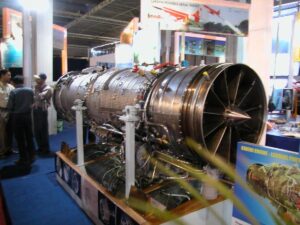For over three decades, a single jet engine has stood as both a dream and dilemma for India’s defense self-reliance –the “Kaveri”. The ambition of India for developing its own jet engine goes way back to 1986, when India’s Defense Ministry authorized DRDO (Defense Research and Development Organization) to develop an indigenous engine for a Light Combat Aircraft (LCA). DRDO assigned lead development responsibility to its Gas Turbine Research Establishment (GTRE), which had some experience in developing jet engines. From there the infamous Kaveri project was born.

Table of Contents
- A brief background of Kaveri Project
- What went wrong?
- Hostile Neighbor, Boarder Unguarded
- Why India needs the Kaveri more than ever now?
- Rekindling the Kaveri project
- So much more than just an “Engine”
A brief background of Kaveri Project
Initially aimed at replacing the General Electric F404-GE-F2J3 afterburning turbofan engine for LCA, Kaveri was expected t produce ~ 80-90 kN thrust with afterburner. Although GTRE had prior experience of development of turbojet and turbofan engine like GTX37-14U after-burning turbojet and GTX37-14UB, the Kaveri project was a new challenge to them.
The GTRE would take Turbofan design and named it as GTX-35VS Kaveri, (after the name of Kaveri River). The project got a final authorization in the year April 1989, which was to be completed in 93 months and projected to cost around ~400Cr Rupees. The project was expected to be completed by December 1996.
What went wrong?
Although the prior experiences of GTRE, the Kaveri project faced many challenges. First of all, developing a modern low-bypass turbofan jet engine from ground up has never been easy. When the project was first assigned to GTRE, they claim to not have proper computational fluid dynamics tools or wind tunnel facilities to study it.
The metallurgical challenges in developing a turbofan jet engine are significant. Extreme operating conditions like very high temperature, begs for alloys with high heat resistance which also needs to be highly Corrosion resistant, Fatigue resistant (components experiences high cyclic stresses) and Creep resistant (at high temperature metals tend to deform under high load).
Developing a jet engine requires decades of research and development. Infrastructure is one key aspect of R&D that decides the faith of the entire project, India lacking proper test facilities like wind tunnels and high altitude test facilities came up as constraint to the project.
Lack of enough funding is another factor that delays the project. So far Rs 2200Cr (approx.) has been spent on the project since its final authorization, it is a mere fraction of what it would have cost to develop a jet engine from ground up in the western countries.
Nonetheless the initial prototypes have displayed a significant performance of ~52kN in dry mode. But none of the prototypes have been able to bypass the 80kN mark even in afterburner mode. The highest thrust ever achieved has been around 78kN.
Hostile Neighbor, Boarder Unguarded
The emergence of China as an economic power-hub has made Indian Border unstable in both Western and Eastern front. The expansionist policies of CCP pose a huge threat to the sovereignty of India, Doklam and Galwan valley disputes, even recent Operation Sindoor (India Pakistan conflict) have taught India the importance of developing its own jet engine.
India now outsources its engines for LCA Tejas, which come with extra vulnerabilities, the west has always weaponized its supply chain, the delays in delivery obstructs the domestic manufacturing process and further delays the actual aircrafts.
Why India needs the Kaveri more than ever now?
- Strategic Autonomy- Reliance on foreign technology for critical military hardware may obstruct the sovereignty of the nation.
- Atmanirbhar Bharat- An indigenous jet engine will push self-reliance of the country to a great extent.
- Raising Defense Needs- Changing times and hostile borders begs for more advanced defense equipments, 5th gen fighter, UAV, Stealth drones, etc.
- Export Potential: Many countries have already shown interest in LCA Tejas, having an indigenous engine will make the process more hassle free and not bound by regulations like ITAR.
- Cost & Maintenance- Although developing jet engine may cost dearly, in the long run it can proved to be more cost beneficial and maintenance will be easy leading to a better lifecycle control.
Rekindling the Kaveri project
Despite the Kaveri engine project has been quiet for past few years, reviving the project could be beneficial for the nation in the long run. DRDO is exploring the collaboration option with French avionics firm SAFRAN to build a new powerful engine for Tejas MK-2. This can be fruitful for Kaveri project. The engine could also be useful for India’s future stealth UAV endeavors. Private sector involvement could be a key step in accelerating the project.
So much more than just an “Engine”
Currently more than 70% of the components of HAL Tejas MK-1 is indigenously made in India. Future of the Indian aviation not only depends upon its future, but also what powers it. Kaveri is not just an engine, it has now become an aspiration of the nation towards sovereignty and thus the trends like #FundKaveriEngine raises time to time.